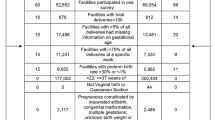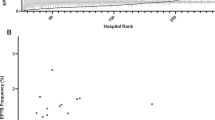Abstract
Objective:
The objectives of this study were as follows: (i) to estimate the proportion of preterm deliveries at a tertiary perinatal center that were provider-initiated versus spontaneous before and after a 2009 policy to reduce elective early-term deliveries, and (ii)to evaluate whether shifts in type of preterm delivery varied by race/ethnicity.
Method:
We performed a retrospective cohort study of preterm deliveries over a 10-year period, 2004 to 2013, including detailed review of 929 of 5566 preterm deliveries, to designate each delivery as provider-initiated or spontaneous. We dichotomized the time period into early (2004 to 2009) and late (2010 to 2013). We used log-binomial regression to calculate adjusted risk ratios.
Result:
Of the 46 981 deliveries, 5566 (11.8%) were preterm, with a significant reduction in the overall incidence of preterm delivery from 12.3 to 11.2% (P=0.0003). Among the 929 preterm deliveries analyzed, there was a reduction in the proportion of provider-initiated deliveries from 48.3 to 41.8% that was not statistically significant. The proportion of provider-initiated preterm deliveries among Black, but not White, women declined from 50.8 to 39.7% (adjusted relative risk: 0.66; 95% confidence interval (CI): 0.45 to 0.97). This coincided with a larger reduction in overall preterm deliveries among Black women (16.2 to 12.8%) vs White women (12.3 to 11.2%) (P interaction=0.038). By 2013, the incidence of preterm deliveries had decreased for both Black (12.1%) and White women (11.4%), and the difference was no longer statistically significant (P=0.7).
Conclusion:
We found a reduction in preterm deliveries after a policy targeted at reducing elective early-term deliveries in 2009 that coincided with reductions in the proportion of provider-initiated preterm deliveries, especially among Black women.
This is a preview of subscription content, access via your institution
Access options
Subscribe to this journal
Receive 12 print issues and online access
$259.00 per year
only $21.58 per issue
Buy this article
- Purchase on Springer Link
- Instant access to full article PDF
Prices may be subject to local taxes which are calculated during checkout

Similar content being viewed by others
References
Hamilton BE, Martin JA, Osterman M, Curtin SC, Mathews TJ . Births: final data for 2014. Natl Vital Stat Rep 2015; 64 (12): 1–64.
Mathews TJ, MacDorman MF, Thoma ME . Infant mortality statistics from the 2013 period linked birth/infant death data set. Natl Vital Stat Rep 2015; 64 (9): 1–29.
Institute of Medicine. Preterm Birth: Causes, Consequences, and Prevention. The National Academies Press: Washington, DC, 2007. https://doi.org/10.17226/11622. Available at https://www.nap.edu/catalog/11622/preterm-birth-causes-consequences-and-prevention. Accessed 17 July 2017.
Brown T, O’Rand A, Adkins D . Race-ethnicity and health trajectories: tests of three hypotheses across multiple groups and health outcomes. J Health Soc Behav 2013; 53 (3): 359–377.
The American College of Obstetricians and Gynecologists. Committee opinion no. 561: nonmedically indicated early-term deliveries. Obstet Gynecol 2013; 121: 911–915.
Healthy Babies are Worth the Wait | March of Dimes. http://www.marchofdimes.org/professionals/healthy-babies-are-worth-the-wait.aspx. Accessed 28 January 2016.
Shapiro-Mendoza CK, Lackritz EM . Epidemiology of late and moderate preterm birth. Semin Fetal Neonatal Med 2012; 17 (3): 120–125.
The American College of Obstetricians and Gynecologists. Committee opinion no. 560: medically-indicated late preterm and early-term deliveries. Obstet Gynecol 2013; 121 (4): 908–910.
Oshiro BT, Henry E, Wilson J, Branch DW, Varner MW . Decreasing elective deliveries before 39 weeks of gestation in an integrated health care system. Obstet Gynecol 2009; 113 (4): 804–811.
Nietert PJ, Ornstein SM, Jenkins RG, Roylance LF, Dickerson LM, Feifer C . The effect of ethnicity on outcomes in a practice-based trial to improve cardiovascular disease prevention. Int J Equity Health 2004; 3: 12.
Agency for Healthcare Research and Quality. 2013 National Healthcare Disparities Report (NHDR). 2013: 1-277. http://www.ahrq.gov/research/findings/nhqrdr/nhdr13/2013nhdr.pdf.
Richardson DB, Kinlaw AC, MacLehose RF, Cole SR . Standardized binomial models for risk or prevalence ratios and differences. Int J Epidemiol 2015; 44 (5): 1660–1672.
Martin JA, Hamilton BE, Osterman MJ, Curtin SC, Matthews TJ . Births: Final Data for 2013. Natl Vital Stat Rep 2015; 64 (1): 1–65.
Murray SR, Norman JE . Multiple pregnancies following assisted reproductive technologies - a happy consequence or double trouble? Semin Fetal Neonatal Med 2014; 19 (4): 222–227.
Fuchs K, Gyamfi C . The influence of obstetric practices on late prematurity. Clin Perinatol 2008; 35 (2): 343–360.
Gyamfi-Bannerman C, Fuchs KM, Young OM, Hoffman MK . Nonspontaneous late preterm birth: etiology and outcomes. Am J Obstet Gynecol 2011; 205 (5): 456.e1–456.e6.
Katorza E, Achiron R . Early pregnancy scanning for fetal anomalies—the new standard? Clin Obstet Gynecol 2012; 55 (1): 199–216.
Young OM, Twedt R, Catov JM . Pre-pregnancy maternal obesity and the risk of preterm preeclampsia in the American primigravida. Obesity 2016; 24: 1226–1229.
Goldenberg RL, Culhane JF, Iams JD, Romero R . Epidemiology and causes of preterm birth. Lancet 2008; 371: 75–84.
Holland MG, Refuerzo JS, Ramin SM, Saade GR, Blackwell SC . Late preterm birth: how often is it avoidable? Am J Obstet Gynecol 2009; 201 (404): e1–e4.
Trilla CC, Medina MC, Ginovart G, Betancourt J, Armengol Ja, Calaf J . Maternal risk factors and obstetric complications in late preterm prematurity. Eur J Obstet Gynecol Reprod Biol 2014; 179: 105–109.
Joseph KS, Fahey J, Shankardass K, Allen VM, O'Campo P, Dodds L et al. Effects of socioeconomic position and clinical risk factors on spontaneous and iatrogenic preterm birth. BMC Pregnancy Childbirth 2014; 14: 117.
Hui ASY, Lao TT, Yeung T, Schaaf JM, Sahota DS . Trends in preterm birth in singleton deliveries in a Hong Kong population. Int J Gynecol Obstet 2014; 127: 248–253.
Massachusetts Births 2013. Office of Data Management and Outcomes Assessment, Massachusetts Department of Public Health. Boston, MA. December 2014. Available at http://www.mass.gov/eohhs/docs/dph/research-epi/birth-report-2013.pdf. Accessed 17 July 2017.
Northam S, Knapp TR . The reliability and validity of birth certificates. J Obstet Gynecol Neonatal Nurs 2006; 35 (1): 3–12.
Ananth CV, Vintzileos AM . Maternal-fetal conditions necessitating a medical intervention resulting in preterm birth. Am J Obstet Gynecol 2006; 195: 1557–1563.
Ferrara A, Kahn HS, Quesenberry CP, Riley C, Hedderson MM . An increase in the incidence of gestational diabetes mellitus: Northern California, 1991-2000. Obstet Gynecol 2004; 103 (3): 526–533.
Acknowledgements
The We thank Laura Dodge, ScD, MPH, David Mediema and Anna Modest, MPH, for collecting data, and Tracey Pollard, RN for helping research assistant MA navigate the online medical records. Presented in oral format at the annual meeting of the New England Perinatal Society, Newport, RI, 13 to 15 March 2015, as well as Mini Grand Rounds of Beth Israel Deaconess Medical Center’s Research Assistant Learning Initiative, Boston, MA, 28 May 2015. Presented in poster format at the annual graduate research symposium of Boston University, Boston, MA, 31 March 2015, as well as the annual national conference of the Asian Pacific American Medical Student Association, Irvine, CA, 26 to 27 September 2015. Dr Heather Burris is funded by the NIH/NIEHS K23ES02224204. This work was conducted with support from Harvard Catalyst-The Harvard Clinical and Translational Science Center (National Center for Research Resources and the National Center for Advancing Translational Sciences, National Institutes of Health Award UL1 TR001102) and financial contributions from Harvard University and its affiliated academic healthcare centers.
Author information
Authors and Affiliations
Corresponding author
Ethics declarations
Competing interests
The authors declare no conflict of interest.
Additional information
Supplementary Information accompanies the paper on the Journal of Perinatology website
Supplementary information
Rights and permissions
About this article
Cite this article
Ada, M., Hacker, M., Golen, T. et al. Trends in provider-initiated versus spontaneous preterm deliveries, 2004–2013. J Perinatol 37, 1187–1191 (2017). https://doi.org/10.1038/jp.2017.116
Received:
Revised:
Accepted:
Published:
Issue Date:
DOI: https://doi.org/10.1038/jp.2017.116
This article is cited by
-
Prematurity-associated wheeze: current knowledge and opportunities for further investigation
Pediatric Research (2023)



